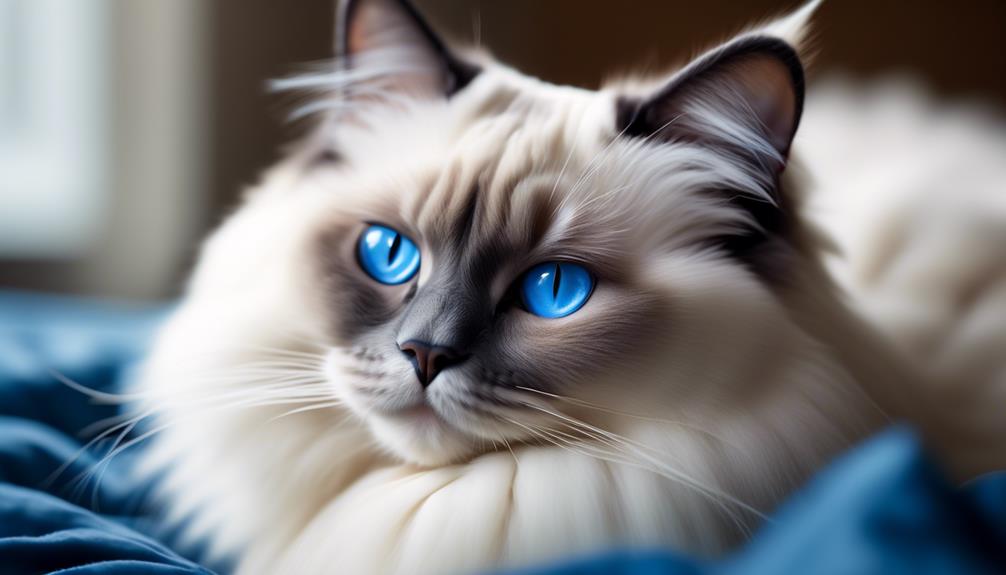
With their captivating appearance and gentle nature, Ragdoll cats have become one of the most popular breeds among cat lovers.
In fact, according to recent surveys, Ragdolls are ranked as the fourth most registered breed with cat associations.
But what sets these felines apart from the rest? From their striking physical characteristics to their unique temperament, there is much to discover about these gentle giants.
So, let’s delve into the world of Ragdoll cats and uncover the fascinating information and characteristics that make them truly special.
Key Takeaways
- Ragdoll cats are large, with females weighing 10 to 15 pounds and some males weighing over 20 pounds.
- They are gentle and affectionate, making them good companions for families and individuals.
- Ragdolls have a semi-long, silky coat with various colors and patterns, requiring moderate grooming.
- Responsible adoption and breeding practices are essential to prioritize the health and well-being of Ragdoll cats.
Physical Characteristics and History
The Ragdoll cat breed, developed in the 1960s by breeder Ann Baker in California, boasts distinctive physical characteristics and an intriguing history.
These cats are large, with females weighing between 10 to 15 pounds and some males weighing over 20 pounds.
They have a semi-long, silky, and soft coat in various colors and patterns.
The breed’s foundation stock consisted of a domestic longhair named Josephine.
Ragdolls have a Himalayan pattern, similar to Siamese-type cats.
What sets them apart is their tendency to go limp when picked up, earning them the name ‘Ragdoll.’
Ragdolls have become a sought-after breed among cat enthusiasts with their gentle personalities, large size, and beautiful long coats.
See another cat breed profile.
Russian Blue Cat
Temperament and Personality
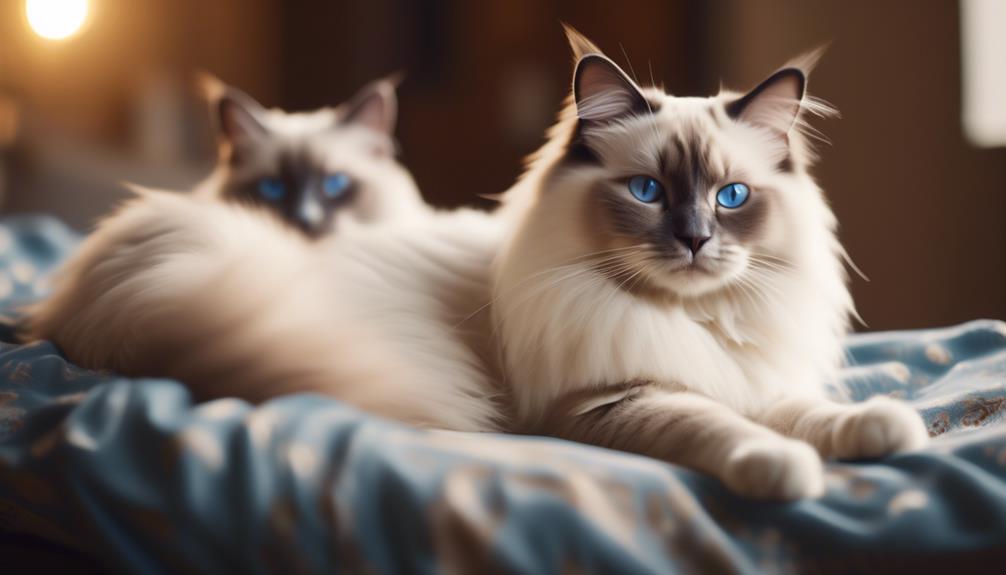
Are Ragdoll cats known for their gentle and affectionate temperament? Absolutely!
These beautiful felines are known to be some of the sweetest and most loving cats around.
Here are four key traits that make Ragdolls so unique:
- Gentle and affectionate: Ragdolls are known for their calm and easygoing nature. They love to cuddle and often flop into the arms of anyone who picks them up, hence their name.
- Good with children and other pets: Ragdolls are patient and tolerant, making them excellent companions for families with kids and other animals. They enjoy being part of the family and will happily join in on playtime.
- Playful and trainable: Despite their relaxed demeanour, Ragdolls aren’t inactive. They love playing with toys and participating in family activities. They can also be trained to perform tricks and exhibit good behaviour through positive reinforcement.
- People-oriented: Ragdolls are incredibly social and thrive on human companionship. They love their people and will often greet them at the door. They’re loyal and devoted companions, making them a joy.
Adoption and Responsible Breeding
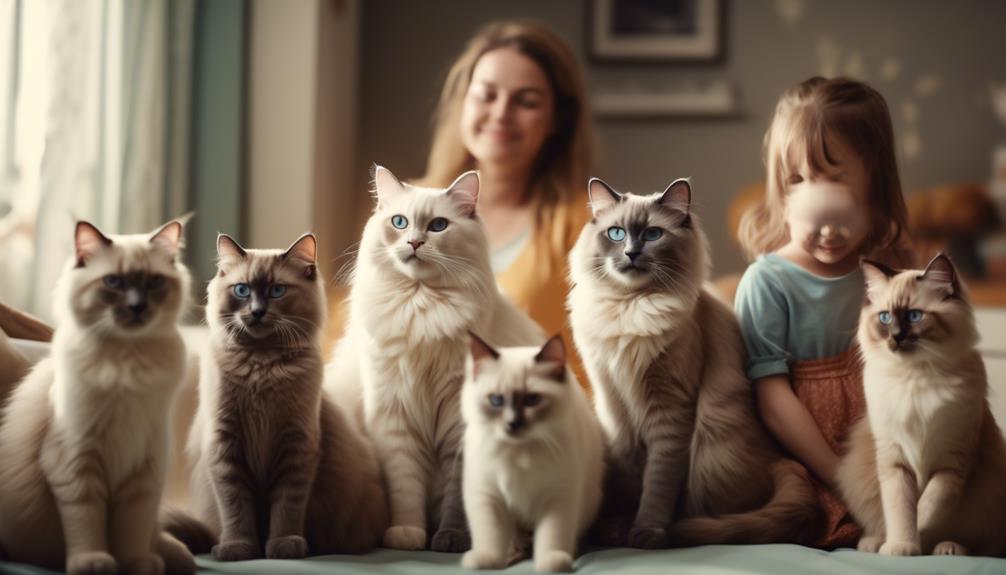
Now, let’s shift our focus to the critical topic of adopting Ragdoll cats and responsible breeding practices.
When considering bringing a Ragdoll cat into your home, it’s essential to prioritize adoption from rescue organizations or shelters.
By adopting, you provide a loving home for a cat in need and contribute to reducing the number of cats in shelters.
If you decide to get a Ragdoll from a breeder, choosing a reputable one who follows ethical practices is crucial.
Responsible breeders prioritize the health and temperament of their cats and conduct necessary health screenings.
They discourage unethical breeding practices and strive to improve the breed.
Famous Owners and Pop Culture References
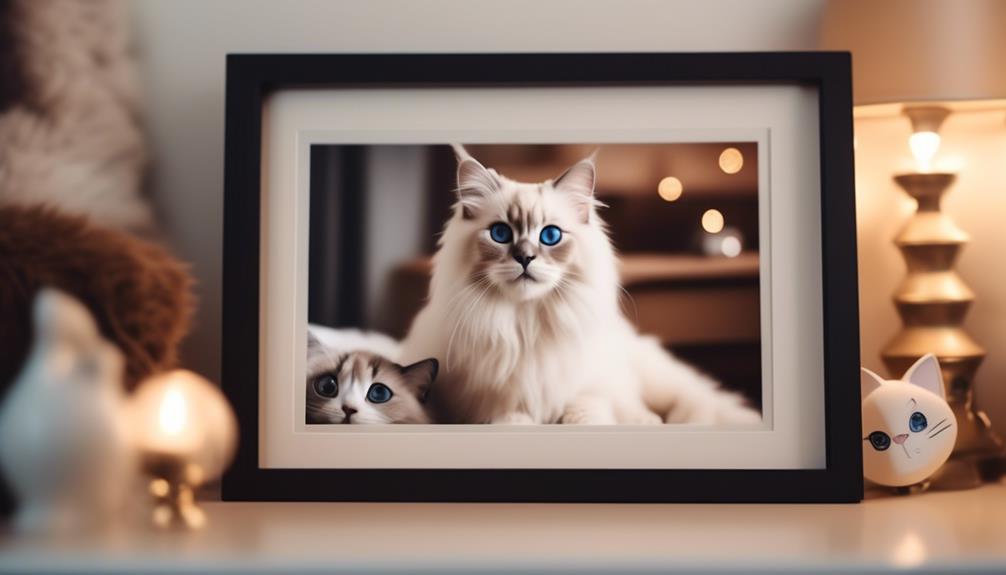
Mark Wahlberg’s character in the film ‘Uncharted’ forms a bond with a Ragdoll named Mr. Whiskers.
This isn’t the only instance where Ragdolls have entered popular culture.
Taylor Swift, a well-known singer and songwriter, owns a Ragdoll named Benjamin Button.
The breed’s stunning appearance and gentle disposition have made them popular among cat lovers.
Ragdolls are sought-after companions and lap cats, known for their affectionate nature and willingness to go limp when picked up.
Their popularity has also led to an increase in demand for them as pets.
With their silky coats and calm personalities, Ragdolls have made a name for themselves in Hollywood and cat lovers’ hearts everywhere.
Health and Care
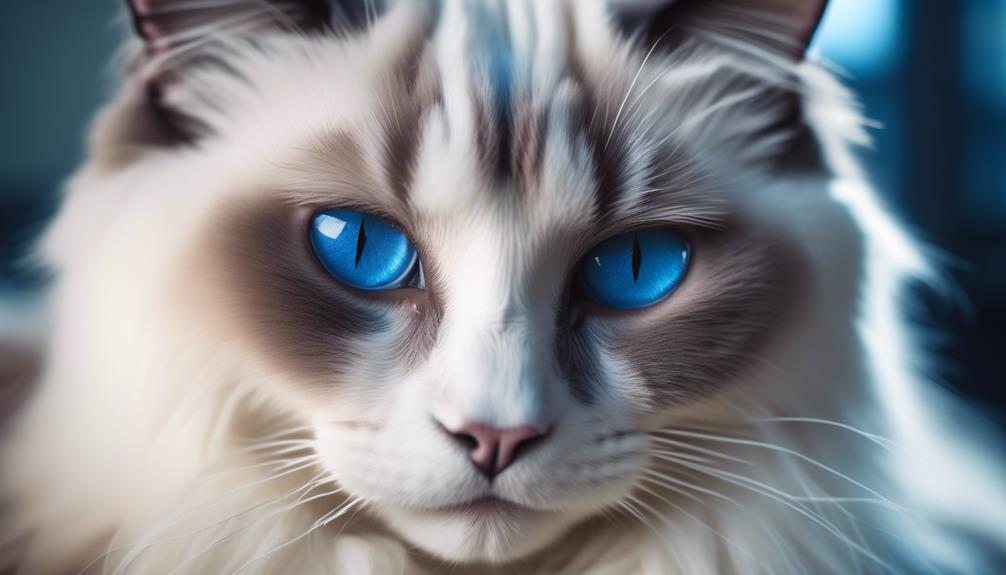
Ragdolls require regular veterinary check-ups and grooming due to their moderately long fur.
They’re prone to certain health conditions, such as Hypertrophic Cardiomyopathy, a form of heart disease, and Polycystic Kidney Disease.
Additionally, Ragdolls may be susceptible to bladder and kidney stones.
Feline Infectious Peritonitis is another severe disease that can affect these cats.
To ensure their well-being, scheduling regular visits to the veterinarian for check-ups and necessary screenings is essential.
Ragdolls have moderately long fur, which requires regular grooming to prevent matting and keep their coat healthy.
This includes bathing, dental hygiene, nail trimming, and ear cleaning.
Maintaining a clean litter box and providing an indoor-only living environment is also recommended for their care.
Origin and Size
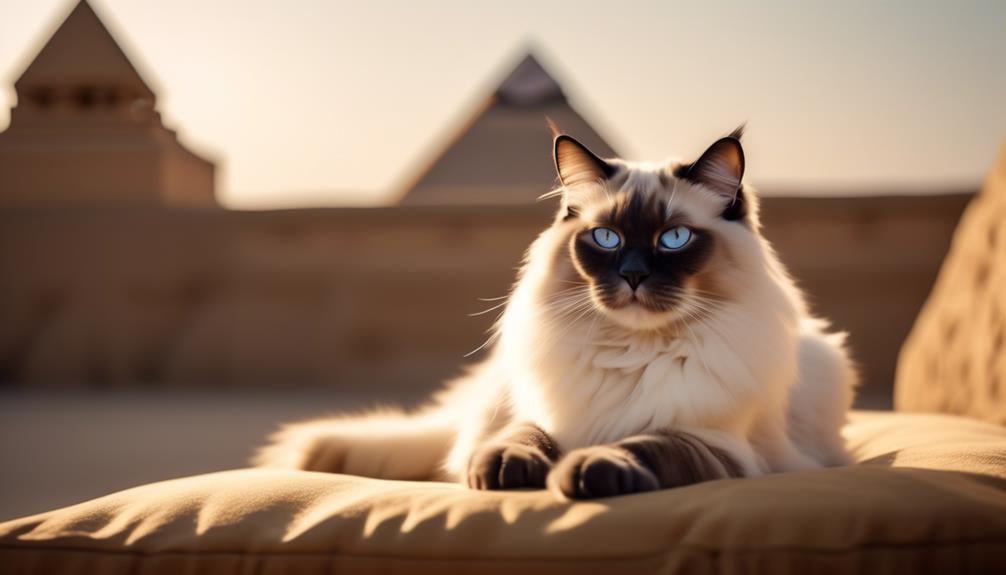
The Ragdoll cat breed originated in the United States and is known for its large size.
Here are some key points about the origin and size of Ragdoll cats:
- Origin: Developed by breeder Ann Baker in the 1960s in California, Ragdolls have a fascinating history. The breed’s foundation stock consisted of a domestic longhair named Josephine.
- Size: Ragdolls are known for their impressive size. Females typically weigh between 10 to 15 pounds, while some males can weigh more than 20 pounds. Their large size adds to their charm and presence.
- Himalayan Pattern: Ragdolls have a unique Himalayan pattern, similar to Siamese-type cats. This pattern, combined with their large size, contributes to their striking appearance.
- The Name ‘Ragdoll’: ‘Ragdoll’ reflects their tendency to go limp when picked up, resembling a ragdoll’s floppy nature. This endearing trait adds to their appeal as gentle and affectionate companions.
Ragdoll cats are beloved for their size, gentle personalities, and stunning appearance, making them a popular choice for cat lovers.
Breed Group and Lifespan
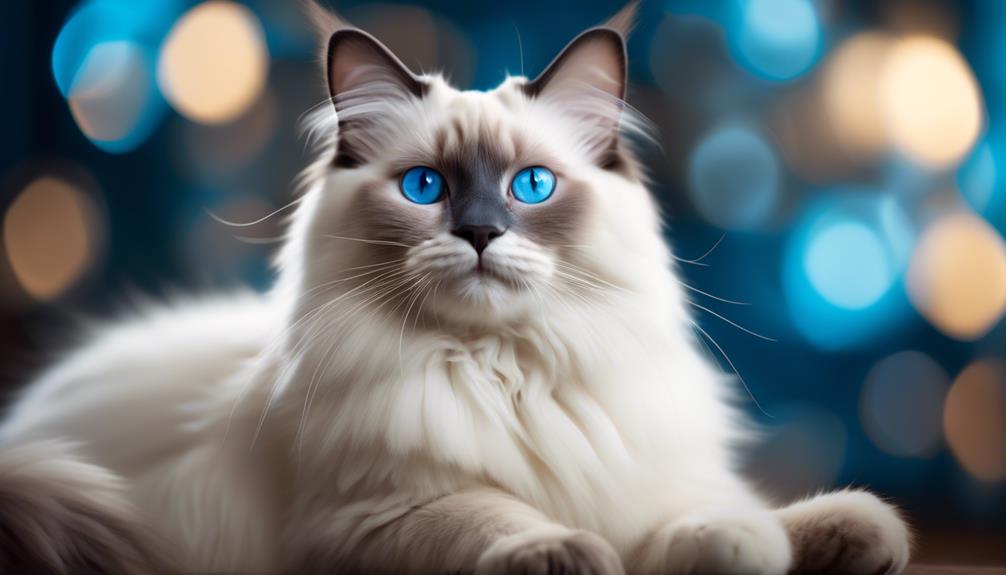
The breed group Ragdoll cats belong to, and their average lifespan is an essential considerations for potential owners.
Ragdolls are classified under the natural breed group. They have a relatively long lifespan, living on average between 15 to 20 years.
If someone brings a Ragdoll cat into their home, they should be prepared for a long-term commitment.
To provide a visual representation of the breed group and average lifespan, here is a table:
| Breed Group | Lifespan |
|---|---|
| Natural | 15-20 years |
Potential owners should consider Ragdoll cats’ specific needs and characteristics, as they are known for their gentle temperament, large size, and beautiful long coats.
Coat Characteristics and Colors
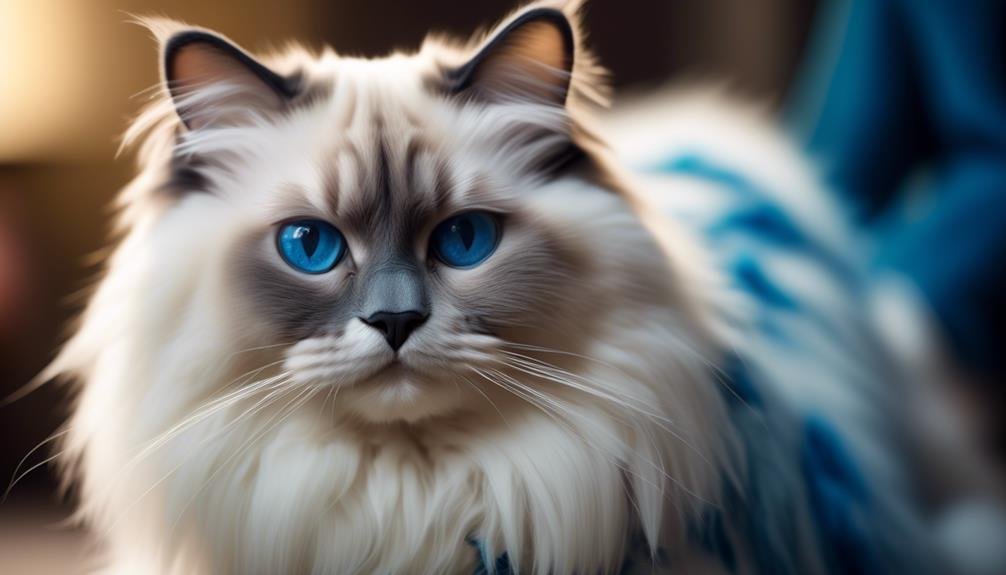
With their natural breed group classification and extended lifespan in mind, it’s essential to explore the distinctive coat characteristics and array of colors found in Ragdoll cats now.
The Ragdoll’s coat is semi-long, silky, and soft, making them a pleasure to pet.
Here are the key characteristics of their coat:
- Length: The Ragdoll’s coat is semi-long, falling between short and long hair. It isn’t as long as a Persian coat but requires regular grooming.
- Texture: The fur is silky to the touch, adding to the luxurious feel of the Ragdoll’s coat.
- Colors: Ragdolls come in various colors, including seal, blue, chocolate, lilac, red, cream, and tortoiseshell. They can also have different patterns like colorpoint, mitted, and bicolor.
- Points: The points of a Ragdoll, such as the ears, face, paws, and tail, are often darker in color compared to the rest of the body.
The Ragdoll’s coat is one of its most striking features, adding to their overall beauty and charm.
Development and Breeding History
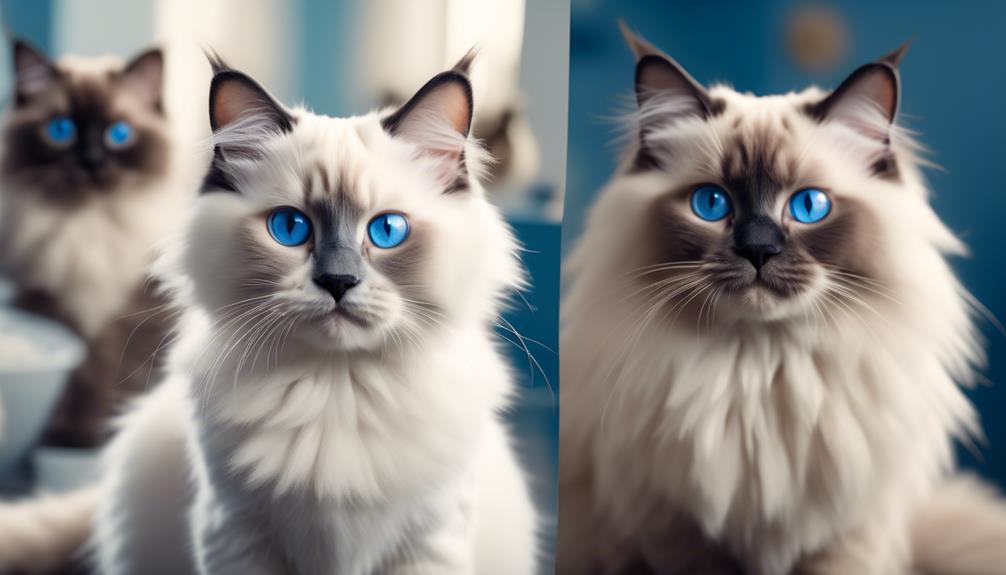
Breeders in the 1960s, led by Ann Baker in California, were instrumental in developing and breeding Ragdoll cats. Ann Baker created the Ragdoll breed by selecting traits such as gentle personalities, large size, and beautiful long coats.
The foundation stock consisted of a domestic longhair, Josephine, with a Himalayan pattern similar to Siamese-type cats.
‘Ragdoll’ reflects their tendency to go limp when picked up.
Ragdolls are known for their stunning appearance and gentle disposition, making them sought-after companions and lap cats.
They have gained popularity in pop culture, with famous owners such as Mark Wahlberg and Taylor Swift.
Ragdolls should be adopted from rescue organizations or reputable breeders who prioritize health and temperament.
Himalayan Pattern and Limp Behavior
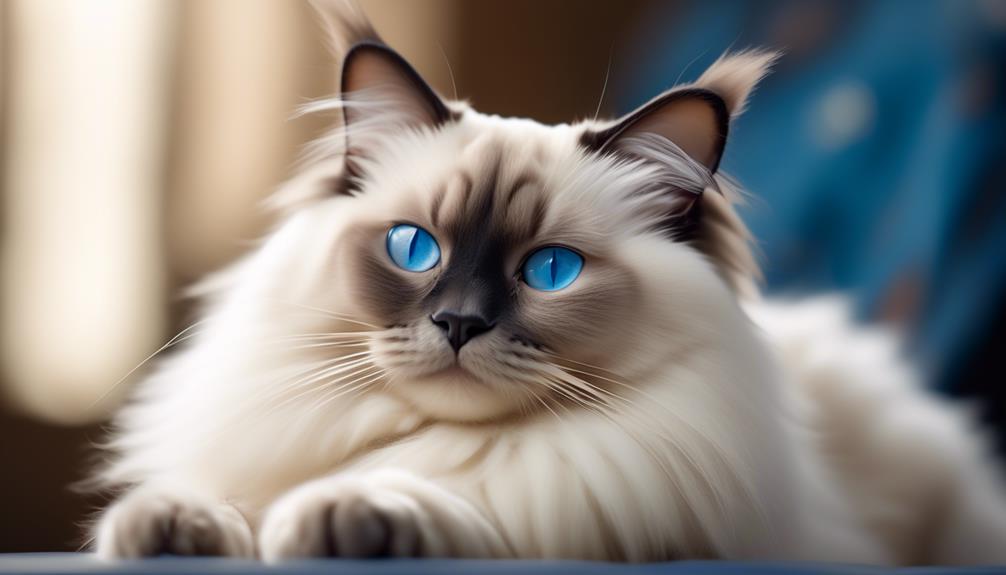
Characterized by their distinctive Himalayan pattern and endearing limp behavior, Ragdoll cats are genuinely unique and captivating.
Here are four key facts about their pattern and behavior:
- Himalayan Pattern: Ragdolls have a Himalayan pattern, similar to Siamese-type cats. This pattern is characterized by dark-colored points on the ears, face, paws, and tail, with a lighter body color. The contrast between the points and the body creates a striking and beautiful appearance.
- Limp Behavior: True to their name, Ragdolls tend to go limp when picked up. This behavior is a result of their relaxed and docile temperament. Ragdolls will often become completely open when held, allowing their bodies to go limp in their owner’s arms.
- Trusting Nature: The limp behavior is a testament to Ragdolls’ trusting nature and their strong bond with their owners. It shows they feel comfortable and safe in their owner’s presence, allowing them to let go and relax fully.
- Gentle and Mellow: The limp behavior is just one aspect of the Ragdolls’ soft and mellow temperament. These cats are known for their laid-back and affectionate nature, making them excellent companions for individuals and families.
Exercise Needs and Trainability
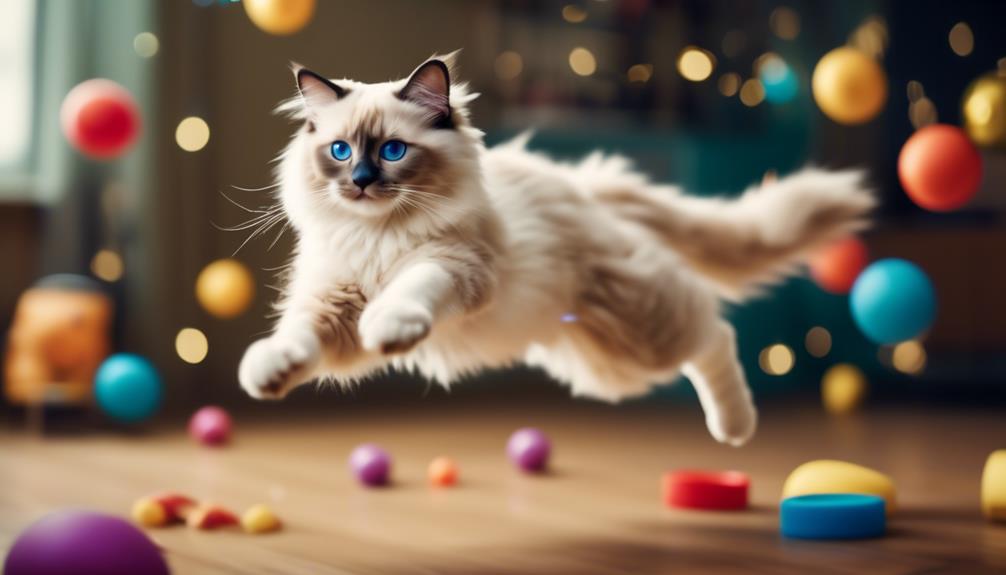
Ragdolls’ gentle and mellow temperament extends to their exercise needs and trainability.
While they don’t require intense exercise, they enjoy playing and participating in family activities.
Moderate exercise, such as interactive play with toys, helps keep them mentally and physically stimulated.
Ragdolls are known for their ability to learn tricks and good behaviors through positive reinforcement.
They’re trainable and respond well to gentle and patient training methods.
Their affectionate nature and desire to please their owners make them eager learners.
However, keeping training sessions short and fun is essential to maintain their interest.
With their calm and agreeable disposition, Ragdolls are a joy to train and make excellent companions for families and individuals.
Good With Children and Other Pets
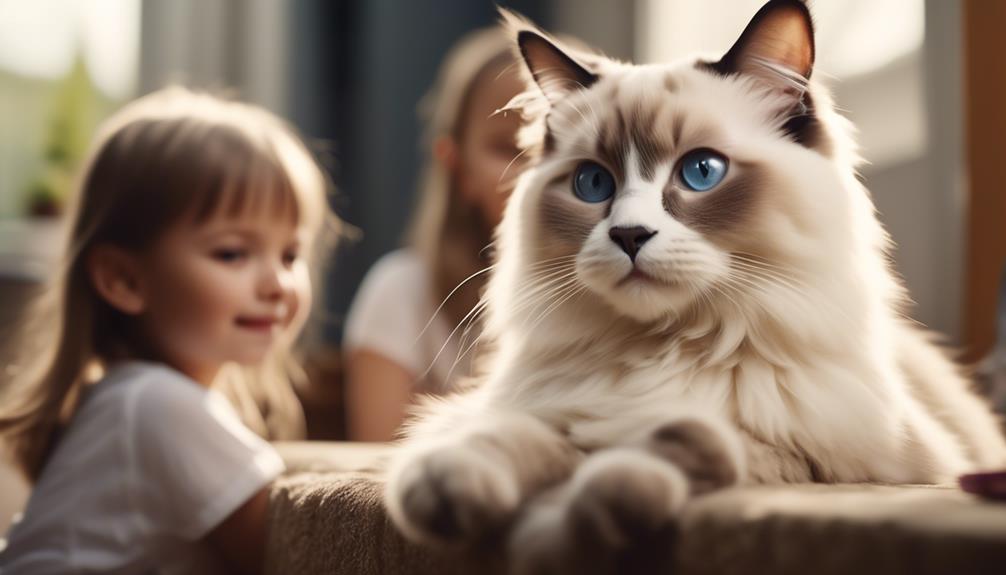
Ragdoll cats are known for their gentle nature and compatibility with children and other pets.
Here are four reasons why they make great companions for families:
- Gentle and tolerant: Ragdolls are calm and patient, making them excellent playmates for children. They’re known to tolerate being handled and enjoy the company of kids.
- Easygoing with other pets: Ragdolls generally accept other pets, whether a dog, another cat, or even smaller animals like rabbits or guinea pigs. Their laid-back nature allows them to adapt well to multi-pet households.
- Non-aggressive: Ragdolls aren’t prone to aggressive behavior, which makes them less likely to scratch or bite when interacting with children or other pets.
- Affectionate and social: Ragdolls thrive on human interaction and form strong bonds with their family members. They enjoy being part of family activities and are always ready to offer love and companionship to children and other pets.
With their gentle and friendly nature, Ragdolls make beautiful additions to households with children and other pets.
Grooming and Training Tips
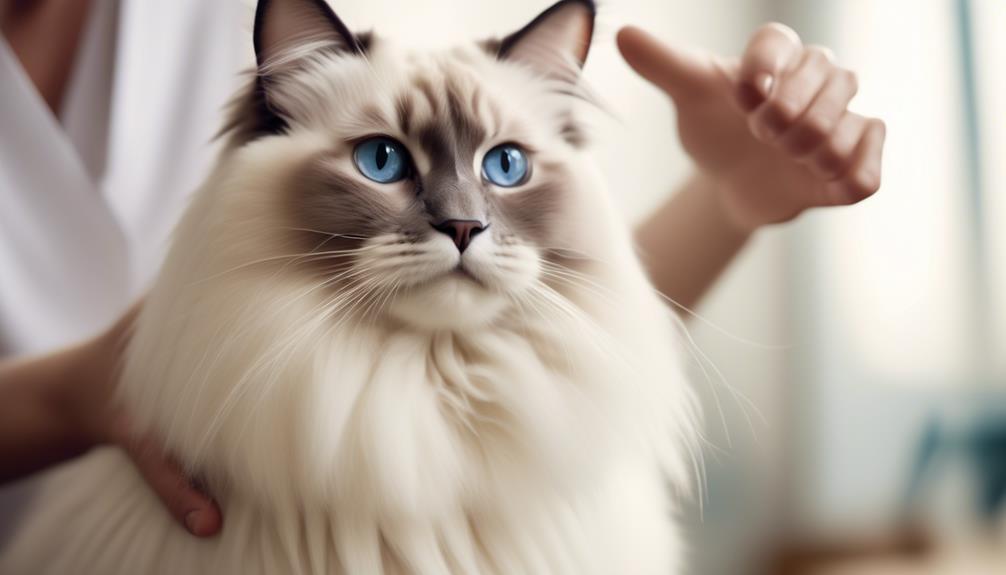
With their gentle nature and compatibility with children and other pets, it’s essential to know some grooming and training tips for Ragdoll cats.
Ragdolls have moderately long fur that requires regular grooming.
Brushing their coat two to three times a week helps prevent matting and keeps their fur soft and healthy.
It’s also important to clean their ears regularly to prevent wax buildup and potential infections.
Additionally, Ragdolls benefit from regular nail trimming and dental hygiene to maintain their overall health.
Regarding training, Ragdolls are trainable cats that respond well to positive reinforcement techniques.
They can learn tricks and good behaviors with patience and consistency.
It’s essential to provide them with mental stimulation and interactive toys to keep them entertained and prevent boredom.
Frequently Asked Questions
What Is the Average Cost of a Ragdoll Cat?
The average cost of a Ragdoll cat varies, but it typically ranges from $400 to $2,000.
Factors like pedigree, breeder reputation, and location can influence the price.
Are Ragdolls Hypoallergenic?
Ragdolls are not hypoallergenic. They have semi-long, silky fur that can trigger allergies in some people.
Regular grooming and keeping a clean living environment can help minimize allergic reactions.
Do Ragdolls Shed a Lot?
Yes, Ragdolls do shed a moderate amount. Their semi-long, silky coats require regular grooming to minimize shedding.
However, their soft fur stays on the brush rather than end up all over the house.
Can Ragdolls Be Left Alone for Long Periods?
Ragdolls should not be left alone for long periods.
They thrive on human interaction and can become lonely or anxious when left alone.
They require companionship and attention from their owners.
How Often Should Ragdolls Be Bathed?
Ragdolls should be bathed regularly to keep their moderately long fur clean and healthy.
The frequency of baths can vary depending on the individual cat, but a general guideline is once every 4-6 weeks.
Conclusion
In conclusion, Ragdoll cats are a remarkable breed known for their stunning appearance, gentle disposition, and affectionate nature.
With their large size and beautiful coats, they’re a sight to behold.
Their laid-back temperament and love for play make them a perfect addition to any household.
Whether you’re considering adoption or responsible breeding, it’s essential to understand their care requirements and potential health concerns.
With proper grooming and training, these lovable companions will bring joy and happiness to any family.




